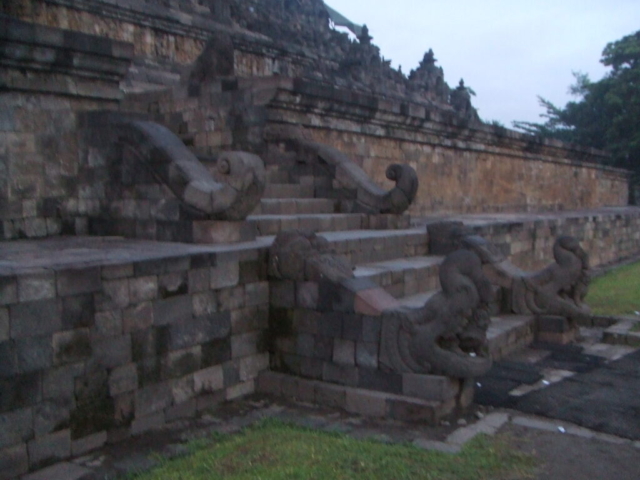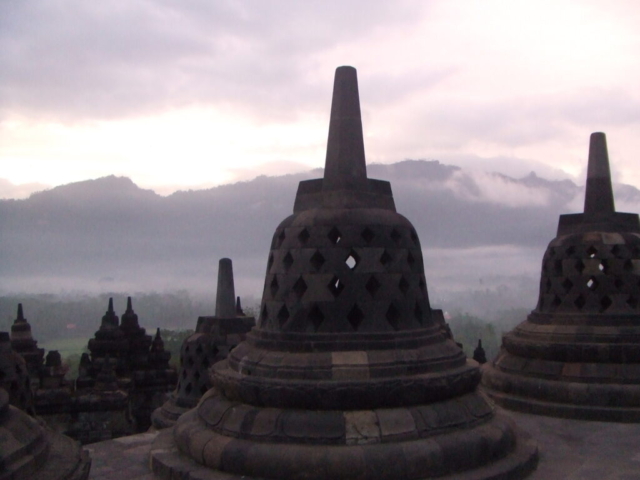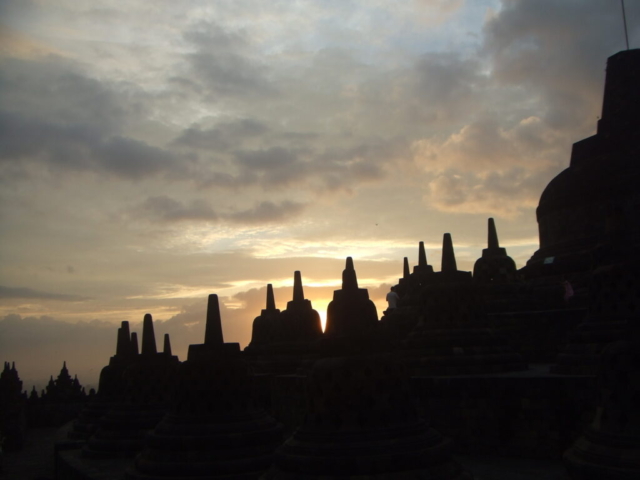Travel dates: 8th December, 2000
If you are a lover of architecture, visiting Indonesia, Borobudur temple in Yogyakarta is a must visit. Approximately 40 kilometres (25 mi) northwest of Yogyakarta and 86 kilometres west of Surakarta, Borobudur is located in an elevated area between two twin volcanoes, Sundoro-Sumbing and Merbabu-Merapi, and two rivers, the Progo and the Elo.
Borobudur, is a 9th-century MahayanaBuddhist temple near Muntilan town in Magelang Regency, Central Java, Indonesia. It is the world’s largest Buddhist temple. The temple consists of nine stacked platforms, six square and three circular, topped by a central dome. It is decorated with 2,672 relief panels and originally 504 Buddha statues. The central dome is surrounded by 72 Buddha statues, each seated inside a perforated stupa.
Built in the 9th century during the reign of the Sailendra Dynasty, the temple design follows JavaneseBuddhist architecture, which blends the Indonesian indigenous tradition of ancestor worship and the Buddhist concept of attaining nirvāṇa. The temple also demonstrates the influences of Gupta art that reflects India’s influence on the region, yet there are enough indigenous scenes and elements incorporated to make Borobudur uniquely Indonesian. more details
common thread of stories suggest that Borobudur lay abandoned and hidden for centuries under layers of volcanic ash and thick jungle growth. Popular theories are that the local population just became disinterested when there were mass conversions to Islam in the 15th century, or they were simply driven away by a large volcanic eruption. It was never forgotten entirely though, with local folklore ensuring that stories of the great monument lived on. The sculptures and toys made from the volcanic rock are special attraction here.
Following the Anglo-Dutch Java War, Java was briefly under British administration from 1811 to 1816. The British governor was Thomas Stamford Raffles (the founder of Singapore), and he took a great practical and academic interest in the history of the mystical island of Java. On a tour to Semarang in 1814, he was informed about a huge ‘lost’ monument deep in the jungles near Yogyakarta, and he sent a Dutch engineer to investigate. It took two months to clear the jungle and partially reveal the amazing monument, but it was not until 1885 that the complex was unearthed in its magnificent entirety. Raffles also presided over the re-discovery of nearby Prambanan, and it is somewhat ironic that the very brief British rule of Java led to the uncovering of both these ancient monuments.
Borobudur was heavily affected by the eruption of Mount Merapi in October and November 2010. Volcanic ash from Merapi fell on the temple complex, which is approximately 28 km (17.5 mi) west-southwest of the crater. During the strong eruption of 3–5 November for example, a layer of ash up to 2.5 cm (1 in) thick fell onto the temple. This also killed nearby vegetation. Experts feared that the acidic ash might severely damage the historic site.
























Recent Comments